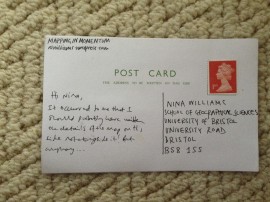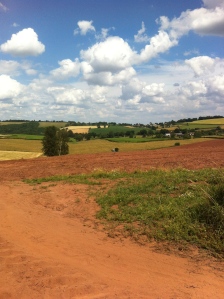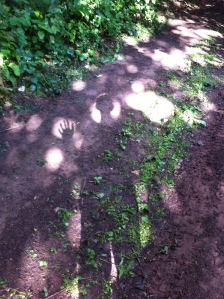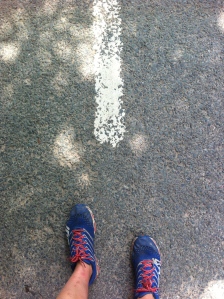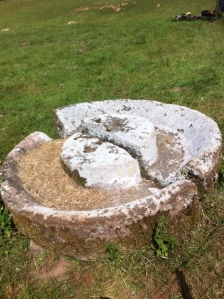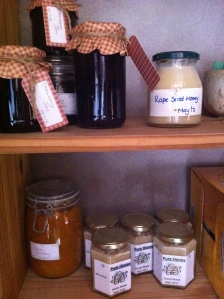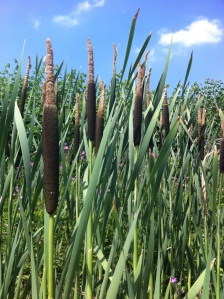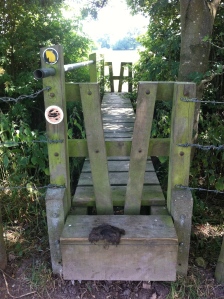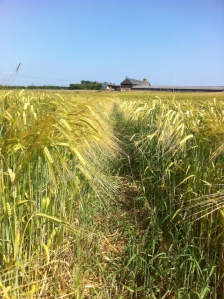All in a Day's Walk
A month-long slow food walking performanceArchive for Walk
Talking Walking (or the Wisdom Teeth of Hindsight)
[I’m writing this with the benefit of hindsight. A whole year’s hindsight in fact. For reasons that will become clear below.]
On Friday 2nd August 2013, I walked nearly 30 miles from my then home in Lea (in South Herefordshire, mere metres from the Gloucestershire border) right across the Forest of Dean to the Green Gathering Festival at Chepstow racecourse. En route I had arranged to meet Andrew Stuck of Talking Walking – the dedicated podcasting website for ‘activism, art, gossip, interviews and news from the world of walking’ – to do an interview that would ultimately be made into a podcast.
He was travelling by train from London to Chepstow, and then planned to walk along the Offa’s Dyke path north of Chepstow. I was to join up with the path towards the end of my walk, so we hoped to walk towards each other and meet at the allotted hour. I would then be interviewed for TW. (It didn’t quite work out like that – though we did succeed in meeting – but more on that anon.)
It did not begin well, underslept and flustered, I set off at 8 am knowing I had about 24 miles to cover before I met Andrew, and very little spare time for getting lost built into the tight schedule necessary to ensure a timely rendezvous.
It was around this time that I’d more-or-less worked out that, on a 1:25,000 OS map, the span of my loosely-stretched hand aligned with a walk’s planned route was approximately an hour’s walking for me. But not allowing for getting lost, tracking back, talking to anyone or an overly wiggly/meandering path.
(I quite liked this one:one scale of my own though – a satisfying physical/temporal take on the one-inch-to-one-mile maps, for a walking geek and a map addict…)
Within half an hour, I had got hopelessly, dangerously lost in a field of >6ft high maize [I am 5 ft 1] that had been planted across the footpath. By the time I’d backtracked, run up a farm track and onto the road to take a longer, alternative route, I already knew that I would deeply regret agreeing to meet someone at an allotted time after 28 miles of walking. That is a lot of miles for mishaps… When the going (and the waymarking) was good, I did have a great sense of bounding through the Forest of Dean: this ancient hunting forest, freemining country, this “strange and beautiful place … a heart-shaped place between two rivers, somehow slightly cut off from the rest of England…” (as Dennis Potter described his home-place).
At other times, I was battling through overgrown undergrowth, with bare legs becoming so scratched and bruised that I eventually drew a sketch of the ‘map’ that the walk had left on me.
By mid-afternoon, Andrew – who had left London without a map and so was attempting to navigate his way from Chepstow along the Offa’s Dyke path by signposting alone – and I ended up in a ridiculous series of mobile phone exchanges. He was asking me to relay directions for him from my OS map, at the same time as I was trying to use it to navigate towards him. But our relative locations spanned either side of the enormous map sheet and so to respond to his requests, I was obliged, one-handed on the phone, to keep unfolding and refolding it.
We did eventually rendezvous – on the Gloucestershire Way, not the Offa’s Dyke path – and walked back towards Chepstow, where, once the calm of navigational certainty had resumed, we found a small meadow high up on the cliff edge of the Wye gorge to do our interview. The sound of drumming from the Green Gathering festival site at the racecourse on the opposite side of the river faded in and out of ear shot with the breeze.
We parted in Chepstow and I walked on alone to the festival, weary, scratched and ready for the wood-heated-water eco-shower that awaited.
***
What happened in the intervening three days is something of a blur – talking to ‘real’ activists: climate campaigners, road protesters, foraging experts, bee advocates, editors of ‘occasional land rights magazine’ The Land; and working in a cafe. I also had a very enlightening conversation with foraging expert Carol Hunt
I set off to return home on Monday 5th August, the penultimate day of the performance. I knew I’d got a long hard walk home and I also, foolishly, couldn’t shake the misperception that it would be ‘more uphill’ going north. I was also cumulatively tired – from the performance, the walking and the festival. So my spirits were dampened still further when there was a deluge of truly biblical, climate-change-freak-weather-type proportions within the first 5 miles: three hours of solid lashing rain, thunder and lightning. It was so wet that rain pooled inside my waterproof map case, having somehow managed to force its way through the almost imperceptible hole made by a thorn on the walk down.
Fortunately my phone, which I’d used to document the entire journey down, including film and audio, was safely zipped into the waterproof Gore-tex pocket of my waterproof Gore-tex coat. But it was not so waterproof as I’d thought. Water even managed to find its way to pool in there too. My phone switched itself off near Bream and refused to reawaken. Running late by the time I reached the middle of the Forest proper, I called in at the Speech House hotel (former hunting lodge and site of “Court of the Speech” for verderers and free-miners) and asked to use their phone to make a call to the dog sitter to let her know where I was.
I was bone weary by the time I returned to Lea. The cottage was eerily quiet, the dogs calmly pleased to see me, the dog-sitter having an evening nap upstairs. I put my phone in a box of rice, hoping for the best. Then I went to bed.
The next day, the final day of the performance, I rested. And waited anxiously for my phone to revive (funny how even eco-activists are so wedded to our technology). I was still hungry and looking forward to my ‘first supper’ the next day. But then on the last night, with no warning – but as if I’d finally earned it – a wisdom tooth chose to emerge. It was painful and I didn’t sleep well. So I woke the day after the performance concluded with the freedom to eat whatever I wish, and ironically found myself unable to eat at all.
[My phone never recovered from its ordeal, losing all my photo documentation from the last 60 miles of walking. So all that remains is the sketch of my scratched legs. Oh well. I suppose it could function as a tastefully restrained Richard Long/Hamish Fulton-esque ‘text work’ or similar: neither of them seem quite so concerned about obsessively documenting their walks through the use of technology. The very thought of either of them Tweeting or blogging (esp. en route) is actually quite a funny one.]
[Images of leg-scratch-map copied and later sent to PhD student Nina Williams for her Mapping in Momentum project]
Wild sleeping
You know when you should have a day off walking when… yesterday the path in front you looked like an appealing place to lie down and sleep. (A couple of years ago on a sunny August morning in the middle of a ten month bout of insomnia, I stopped on a journey from Hereford to Bristol and walked up May Hill looking for somewhere to sleep. In my sleep-deprived madness, I wondered if I could write a lavishly-illustrated coffee-table book on Wild Sleeping to add to the glut of wild swimming and cool camping ones…)
Today I’m tired: the sudden arrival of starchy carbohydrates (oats) in my diet has replaced hunger with a heavy, profound tiredness. The sudden arrival of clouds, cool weather and a breeze has replaced the artificially energising effects of sunlight and revealed an exhaustion I didn’t know was lurking.
So we’re sleeping (me and hounds) and I’m writing. By which I mean blogging retrospectively.
I’m not very disciplined when it comes to writing: not doing it at all, and then doing too much. As my supervisor says, I write like I talk, wanting to say it all – everything about everything – all at the same time (parentheses within parentheses) interrupting the flow in the process.
I find documenting walking through writing (as in this blog) is incredibly counterintuitive. While I know that writing and walking are both forms of thinking (writing is the best form of thinking, my supervisor tells me; walking is the best form of thinking argues Robert Macfarlane; walking and writing are compatible forms, with walking providing a reflective space to contemplate one’s writing, balances Tony Williams) to me they are mutually exclusive. Perhaps this is because they both take my energy in different ways.
Walking stimulates thought but ultimately brings me to a quiet stillness. It’s a linear, directional, space-eatingly satisfying, multi-sensorial engagement with the world. It gives me energy at the same time as it exhausts me.
Writing is an attempt to tether and order that thought, but it agitates me in the process. It’s a non-linear chaos of words in my head emerging through the dam of my fingers, the sluice gate of the pen or keyboard, as a tamed stream of communication. It makes me restless at the same time as it saps my energy.
They tire me in different ways but equally, so I can only do one or the other. I don’t have the energy for both.
It’s an imaginative leap over the stream of poetic license, but as I’m always going on about dichotomy and disconnectedness as lying at the root of our inability to do more about impending climate doom, I wonder if maybe this writing/walking conundrum is representative of those fundamental dichotomies. And that they are more deeply scored in all of us and harder to reconcile than we think.
Vegan roadkill
A walk through Dymock to Brooms Green, home of Charles Martell cheeses. I’ve been intrigued by this cheese-makers-cum-distillery ever since I’d heard my friend Hugh (himself of the inspiring artisan cider-producing Dragon Orchard) waxing lyrical about them back in December. I wasn’t eating cheese or dairy then of course due to a suspected allergy, but this time around and in the absence of allergy, their delicious nettle-wrapped May Hill Green has been very sustaining on long walks. I set off late today with a belly full of it. I haven’t called ahead to arrange a meeting, optimistically hoping to bump into someone when I arrive. Or simply for the walk to guide me into an encounter with someone else.
I don’t and it doesn’t. In fact, I barely see anyone closer than waving distance: two farmers mending a trailer and a lone dog walker. So much for talking activism today.
I pass through a sinister concrete bridge under the M50 that looks like it should house a 1960s concrete troll and join up with the Daffodil Way, round the edge of Dymock Forest. I pass an equally sinister looking mansion which instantly makes me think, with a goosebump frisson, of Sarah Waters’s The Little Stranger. For miles it seems to be watching me with coolly blank eyes, and I wonder why we anthropomorphise houses when really, they are just hemmings-in of space for us to shelter in.
In Dymock I find myself following the Poets’ Paths to Brooms Green. It’s not intentional. In fact, there’s something vaguely embarrassing about it. Perhaps this is because I’m always achingly conscious that walking seems to have a tendency to turn everyone into a navel-gazing poet or philosopher of varying degrees of awfulness, something I’ve been anxious to avoid through informing my walking practice with my environmentalism and other political concerns, of varying degrees of gentleness. By this, I mean that I’m permanently hyperconscious that, for all that I was at pains to put activism in tracktivism, I know there’s still nothing overtly, tub-thumpingly political about it. And inevitably, in the luxurious engagement with natural world that rural walking offers, the political is not present for me in every step. I am not a pilgrim. I can allow my mind and senses to wander.
What I remain conscious of, however, is that this is no rural idyll. These farmed landscapes are constantly changing and responding to the challenges of economy and climate. Less obvious, dramatic and dizzying than the melting ice-sheets to be sure, but still more fragile than we think. As our oil dependency continues and rural infrastructure falters, maybe we should all be walking these paths and writing bad poetry while we still have the chance? In less time than has passed since Edward Thomas, Robert Frost et al. were walking here, who knows what these landscapes will look like as a consequence not only of changing weather patterns and climate but also resource depletion and population explosion.
On the way home, I’m really hungry. I only brought a small sorrel and beetroot salad with me (no cheese or oatcakes), it’s 7 pm and I’ve walked about 17 miles, 5 more to go. Then I see on the side of the road a whole broad bean plant that’s been pulled up and dropped (by a creature? off a trailer? I’m not sure). Some of the pods are broken, but some are intact and I liberate the beans. Vegan roadkill, I think. At a green activists’ event earlier in the year, I’d been speaking on a forum about local food, revealing my epiphany that I’d suppressed my ethical concerns over killing animals to eat in favour my environmentalist understanding that pasture-fed (and finished) meat was a more carbon-neutral form of local protein (and very likely also a healthier one, than grain-fed meats). A vegan member of the audience had disagreed: with enough planning, she said, we were more than capable of growing enough beans to make enough protein to feed ourselves locally and ethically. The beans dont give me much oomph, but in my ongoing unease with eating meat and dairy, I wonder if she’s right.
What I think about when I walk about talking
A walk back from Caplor to Lea. It’s a rite of passage: having lived at Caplor for a decade but moving to Lea, I’m leaving home and walking home at the same time. It’s a walk I first did back in early January, and repeated a week or so later in thick snow. Now I’m carrying strawberries and wearing shorts and sunglasses.
I’m carrying the strawberries (from Holme Lacy, purchased at the Caplor Farm Shop) because I can’t fit the punnet in my rucksack. It’s annoying, carrying them in my hand, so I’m attempting to eat them, but I don’t feel that hungry. What a conundrum: to carry in my hand or my stomach? It reminds me of something our fitness trainer once told us in dance training, that our stomachs are as big as our two hands cupped together, and that this is the amount we should eat in any one meal. Suddenly that makes even more sense: surely as naked, unpocketed, unrucksacked hunter-gatherers, we would only have been able to eat as much as we could carry in our cupped hands?
Yesterday, I bumped into friends in the Rocket Cafe in Hereford. I explain the project to them and they ask ‘what do you think about then, when you’re walking?’. They want to know if I remain constantly conscious about what I’m doing – the wider, activist ethos of the performance – or if my mind wanders onto other things. It makes me smile because only yesterday morning I was furiously composing an email rant in my head.
The relationship between walking and thinking, walking and writing, running and thinking has been so often discussed – and far more articulately and sophisticatedly than I can hope to – that I’ll leave it to the experts. But, while in my own practice I like to think I’d be able to keep the intention of the walk and the overarching performance running through my head, inevitably the rest of life intrudes. (To empty my head, I speak phenomenally long to-do lists into my phone and that seems to help.) That said, I’m so often passing through fields of food crops, there are constant visual, aural (rustling wheat and barley, tractors droning in the distance, cows snuffing and huffing as I pass), tactile (maize leaves whipping my face) reminders of what I’m doing which serve to tether my attention to food and farming.
Hereford
A walk to Hereford, for a meeting at All Saints Cafe about an installation and walking performance for h.Energy this autumn. (I’m going to be walking in circles around Hereford city, carrying water with an antique milkmaid’s yoke, but that’s another story.)
It’s a long way, and I’m walking halfway back again too before this evening, so I give myself permission to ‘just walk’. I need to get there on time, in time for our meeting at 2. I set off at 7.30 and arrive at exactly 1.30, I seem to be better at timing my arrival when walking even across unfamiliar terrain than I ever am when travelling by other means. Maybe that’s because, on foot, my soul is travelling at the same speed as my body.
I’m bothered by a steady stream of commuter traffic on the road up to Crow Hill, but once I cut across Eaton Park wood and drop down to the Wye Valley Walk, it’s idyllic and tranquil and I’m suddenly the disruptive force: my feet send up butterflies and damselflies from the long grass with every step.
I arrive into the bustle of the city to find it’s the weekly farmers’ market. I speak to Dave who, I read somewhere, refers to himself as ‘the man with the hat’. He tells me that market has been going about 13 years, waxing and waning and waxing in size over that time. I ask if people – customers – ask where the produce or plants come from and he tells me that they often do, and are pleased when they hear that they are his own plants. Because then he can answer questions about them. There are lots of what he calls ‘secondary producers’ here – people selling pies, cakes, preserves or other delights which are made locally and with mainly local ingredients but necessarily combined with others sourced from further afield (like sugar or spices for preserves and confectionary of course). All these are outside my current rules so I can’t buy anything today. But I see that the vegetable stall is from Kidderminster in Worcestershire: he says they set a radius of 40 miles ‘which is quite far’ (I agree, outside my daily walking distance) but that they get enquiries (which they turn down) from sellers as far afield as London wanting to attend. It strikes me that this – the London enquiries – is ‘local’ retail gone mad. It reminds me of a criticism I’ve heard in the past, that many farmer’s markets (but not this one, which is excellent) are far from that; selling over-priced artisan produce and crafts aimed at a monied middle-class market, pricing genuinely local food out of most people’s range. It strikes me that it’s doing more damage than good to people’s faith in the concept of local food, and working in supermarkets’ favour.
Which is a massive shame, because where else than a genuine farmers’ market can the farmers, growers and makers connect directly with their customers and their customers with them? And have important conversations, literally over the produce itself, that allow them to explain the real cost of producing food: prices that reflect a difficult winter, a late spring, more expensive grain, a poor harvest, or the time, effort, love they invest in making it… Then we understand that when we buy food others have grown, we are paying for more than taste and calories: we’re rewarding the growers appropriately for genuine craft, commitment and consciousness.
Dams and damsels
I seem to be annoyingly addicted to alliterative blog titles, but I’m just going with it for now.
A walk to Ross-on-Wye and back with my friend Jessie, who is fasting for Dharma Day. It’s the first time I’ve walked with someone else this time around and the baking heat is a total contrast to the freezing hoar frost of my walk with Alison to Much Marcle in December. It’s also humbling to walk with someone who is intentionally and ungrumblingly fasting for spiritual commitment, rather than unintentionally, haphazardly and whingeingly for eco-activist performance.
Last night we sat around the fire in the gloaming and cooked Hope’s Ash and Crooked End beef steaks, picked and ate salad and herbs from the spiral, and, in the cauldron, boiled new potatoes from the field next door. Our own lettuce is growing faster than we can keep up; peas, beans and beetroot are nearly ready.
Today, on our way to Ross we pass through Hope’s Ash Farm again and bump into Robert on the yard. He beckons us over, stops the tractor and opens the door. There’s a slightly pregnant pause and I’m starting to worry that I’ve done something wrong when he says ‘I read your blog last night and it was the first blog I’ve ever read’. He seems to approve of it, and it’s given him some food for discussion (on veganism, dairy and meat) with an A-level student who is currently with them on work experience, heading for veterinary training. He asks me if I’ll have a chat with her about veganism which, he says unlike vegetarianism ‘which is easy’, he believes ‘really is hard’. So I do – ironically, standing with her in the pens of the day old dairy calves necessarily removed from their mothers so that we can drink milk, ‘the guilty secret of the dairy industry’ rearing its beautiful bovine head again.
Jessie and I walk on, talking about Buddhism, vows, our reluctant flexitarian meat-eating and its contradictions. We sprint, squealing, along the edge of a potato field, only just timing it right that we avoid a drenching by the rotating irrigator. Then we drop down and past the massive, industrial-scale Cobrey Farm: acres of fruit and pickers’ static caravans. We pass what I assume (from their accents and dress and our exchange of smiling, gesticulating nods) two European farm workers, also walking into Ross and playing music on their phone speakers as they do. It prompts us (Jessie and me) to discuss how more and more often (as Rebecca Solnit writes) we (culturally not personally!) think of walking as waste of time, a dead space to be filled with music on iPods or mobile phone conversations, neglecting the sensual pleasure that walking has to offer, not least as a mode of engagement with environment and self. We also talk about mobile phones, EMFs and the subtle body: are we living in a massive, global experiment that is scrambling our selves and our eco-systems, our bees and our pollinators and so ultimately our agriculture?
Dropping down into Ross and I make a beeline for Field Fayre, my local, organic, wholefood shop and recent joint runner-up (with Waitrose no less) as ‘organic retailer of the year’. I explain to proprietor David that this is the summer repeat of my winter performance (during which I’d first called in at the shop) and he talks me through the baskets and baskets of local produce. Because the shop is registered with the Soil Association, their remit is to sell certified organic produce, which means using European stock at certain times of year. But now, he says, it’s like ‘a dam bursting’: suddenly all the local producers have got everything:
We call in at delicatessen Truffles too on our way home – I want to thank them for their earlier generosity. They’re actually closed, but Richard opens the door in response to our persistent knocking and talks us through the huge range of Herefordshire produce they stock.
We walk back through Kingstone and stumble upon (if that’s possible), Bollitree Castle. We’re a bit disappointed that it appears to be a façade, but nevertheless I take photos of Jessie – with her spectacular Rapunzel-like mediaeval damsel hair – knocking on the door. When we get home, my partner tells us it’s the country home of Top Gear’s Richard Hammond. Surprisingly (for an eco-aware Buddhist) Jessie is a big fan. Later, I email her the pictures, laughing stupidly at my own subject line: ‘knock, knock, knocking on Hammond’s door?’
This little piggy went to market
A walk to Ruardean again to buy vegetables and meat. We have another friend – Jessie – coming for dinner later and I want to see what new produce is springing forth from the Crooked End garden since the last time I visited. In terms of local produce, I seem to have timed this summer version of the performance perfectly as a walk up a seasonal produce see-saw: it was nearly at rock bottom when I started the uphill climb but now I’ve passed the fulcrum and it’s tipping me downhill into overabundance. (Though I’m still struggling to find enough stodgy carbohydrates to support a long distance walking practice – or my own metabolism’s pace and eccentricities – but more on that anon.)
I’m walking without the dogs this time, so I’m much speedier (stiles and sniffing slow you down with hounds). But I seem to ‘read’ landscape according to my very first encounter with it, so this second walk along a route I first encountered with dogs I’m remembering the stiles that were impossibly hard to throw a hound over, or the fields of sheep where I keep them close to me (dogs chase sheep), or cows where I don’t (cattle chase dogs and I’ve been told it’s best to let your dogs off the lead to avoid being trampled yourself).
I also realise that, when I’m focused on the young dogs (are they safe? are they within sight? are they chasing something they shouldn’t?), I am experiencing the landscape more through the things their multiple senses (eyes, ears and snouts) alert me to. I have a lesser sense of the topography and terrain and my own physical or emotional response to it; it even subdues my awareness of the immediate discomfort of nettle stings. But walking this route again, which takes me up over Lea Bailey and into the Forest of Dean proper, I am more aware this time of leaving the familiar pastoral landscapes of South Herefordshire and entering labyrinthine woods with a concomitant sense of wildness and enclosure but also, paradoxically, vastness. (I remember a reading in a John Wylie paper a Gaston Bachelard quote: ‘we do not have to be long in the woods to experience the always rather anxious impression of “going deeper and deeper” into a limitless world’.)
Thinking again of landscape empathy, I realise that (of course) our true ‘sense of place’ is much more closely allied to our personal awareness of or relationship with topography and scale and the ‘recognisableness’ of landscape than administrative (county) boundaries (which I tend to be geekily hyperaware of, having worked as a landscape mapping officer for two local government authorities over the past decade). Even though we live in South Herefordshire, my partner always says by way of explanation to others that ‘we live in the Forest of Dean’. It used to intrigue my pedantic self, because strictly speaking we don’t, but now I get it: it is a highly characteristic and more recognisable and descriptive landscape area which I already feel an affection and affiliation towards. Landscapes are, of course, better defined by the perceptions of the people within them.
I also realise that it’s by situating ourselves firmly in our own filltir sgwar (a Welsh phrase, literally translated as ‘square mile’ but meaning that place which you own through familiarity and which ‘owns’ you [and] needs your vigilance), that we can begin to address wider concerns, because it gives us a context: while such a localised practice as mine could be accused of parochial tendencies, I feel that by settling in, I’m better placed to look out. As long as I don’t fall into the trap of thinking that this rural idyll is all there is. (It’s OK, they sell the Guardian in the village shop.) Having recently watched Quadrophenia for the first time (I’m a few decades behind when it comes to popular culture), it makes me think that as we become separated from landscape, we become artificially tribal: inventing difference to cultivate an ultimately flawed sense of belonging to something, anything.
These musings aside, it’s when I’m passing the stile that I remember as most hideously dog-bothersome, that I see some beehives in a next door garden. I also see some people, and stop to ask them about bee-keeping (we are thinking of getting a hive for the garden). They – Steve and Sarah – are immediately helpful and welcoming. We get talking about bees, but also the project more widely, local food and meat: it turns out they have pigs, hens and a whole smallholding of wonderment. (Even peaches in the greenhouse.) Sarah kindly takes me on a tour of the pigs, the fruit canes, vegetable garden and, finally (and most surprisingly) ‘parma’ hams hanging in the cool under a tree in their garden (though, as Sarah explains, they can’t be sold as parma ham because this is an EU PDO… and we’re full circle back to our allegiance with place and landscape). She muses, they might call them ‘Harechurch Hams’ and you can hear an audio walk through the journey from farrowing pen to tree here:
Equine empathy
Yesterday was a long and hot and hungry horse-relocating day. (I got so faint and stomach-crampy, that my partner fed me some non-local sourdough bread. Sorry, but it was necessary.) Now Merlin is calmly installed in his new home next to the growing vegetables (Martin the proprietor of Adam’s Cot is also a supplier of excellent local veg boxes).
Today is about beginning to cultivate Merlin’s own landscape empathy.
Back before I even contemplated or conceived of the idea for this performance, I’d long been interested in connecting my artistic and domestic practices, or my rituals of exercise (walking, running, riding) with more practical pursuits. (I waffled on about this way back in December in ‘Home is where the art is…’. But more and more I am discovering that this is becoming a preoccupation for many artists, interestingly most often those living and working rurally.)
At Caplor, one of my favourite short rides on Merlin was a jaunt (usually bareback) across the lanes and fields to buy honey. This route became known, famously, as the ‘Honey Run’. Here I already seem to have discovered a new equivalent: the walk up to Aston Crews to buy duck eggs. ‘Duck Run’ isn’t cutting it, but they have hens eggs too. So, with apologies to Aardman, it’s ‘Chicken Run’.
Heat and honey
An admittedly gruelling walk in 30 degree heat from Lea over May Hill to Highnam and Over Farm. It’s only about 25 miles, but it takes me 8 hours: I’m fast heading out but weighed down by vegetables, fruit and sun-weariness on the way back. Even as I set off in the morning, the waves of heat are palpable: we talk about the sun beating down, and all day I feel it like a slow hammer thudding me into the ground. I seem to be sweating all I’m drinking from my water reservoir straight back into the padding of my rucksack, so the weight is constant. Even ‘SPFd to ye max’ (as my friend Lewis sensibly advises – we have an acronym thing going on), my skin feels like it’s cooking. But, for all this whingeing, I’m not complaining. After the extreme rain and mud of December this is a welcome contrast. Though I do find myself musing about my canny knack of inadvertently planning my walking to coincide with extreme weather events – perhaps an unconscious climate change consciousness after all. That said, just the thought of ‘global warming’ in this heat makes me feel claustrophobic and nauseous. Walking across one particularly dry and scratchy field (I’m finding the long vegetation at this time of year is as difficult to walk through as December mud, plus I’ve developed an exaggerated allergic reaction to nettle stings) then grateful for momentary cool and shade passing through a thick treed hedgerow, I think about a future with less water, less shade, less space, less land area, more drought, fewer crops and more people to feed. It’s frightening…
Heading up towards May Hill, I pass a garden full of loganberries, fields of ripening oats, wheat and potatoes. Herefordshire is like a glowing, rounded expectant mother. This year feels like it will be a good harvest. But right now it’s locked in and inaccessible to me. And even when it bursts forth, how much of that crop will be shipped away from here to be ‘made’ or processed into food?
Striding up the lane, I pass a parked vehicle. ‘You’re off somewhere in hurry!’ a friendly passenger remarks. I explain I’m headed over to Over and have to get back within the day. I explain why and we get talking about local food. ‘You’ll be proud of me,’ she says ‘I took 100 litres of honey off my hives last week’. We then work out that it was her honey – ‘Happy Honey’ – that I’d bought at Brown and Greens two days ago, though she lives in Gorsley not here, so this really is coincidence. I’m curious about her perspectives on honey and the much-talked-about plight of the bees and she kindly agrees to share them:
I join the Wysis Way to walk up onto May Hill proper. Grasshoppers are chorusing in the long grass
I pass Taynton farm shop, the bottles of apple juice displayed on doilies (I thought they were extinct). I would like to buy some duck eggs but agree with the proprietor that in this heat ‘they’ll be cooked by the time you get home’.
I get lost after Taynton but find some bulrushes (reedmace) in a pond. I don’t pick any but I do know their rhizomes are a year-round source of carbohydrates (I’m not quite brave or hungry enough to try).
I pass High Leadon, Highnam, have a conversation with an elderly woman about cherries and am followed by curious cattle along the banks of the River Leadon.
A few miles off Over Farm and I know I’m on the right track: there is a strawberry-shaped helium balloon tethered above the pick-your-own fields. I contemplate picking-my-own and then decide, it’s a four hour walk back and I might save myself for today. Inside Over Farm market is a local food treasure trove: this is what they are passionate about and all the produce has a ‘food miles’ label. Satisfyingly, much of the produce is coming from the farm itself, so the labels read ‘less than 1 mile’ or ‘0’. I want to punch the air and whoop, but that’s a bit geeky. Then at the cheese counter (some more May Hill Green) I interview two young members of staff, Tom and Hannah. Both in their very late teens or very early twenties (I guess), they have some admirable perspectives and knowledge on local food, community and animal welfare. I ask them, is this typical of their peers?:
I slog home eating strawberries, grateful for the cool as the sun drops. As I curve around the contours of May Hill, heading directly west into the sunset, I pull the May Hill Green cheese out of my rucksack and ceremoniously eat the whole block. It’s rather poetic: eating a nettle-wrapped Gloucestershire cheese on May Hill with nettle stung legs.
Activism in tracktivism 2
Once upon a time, I walked around the Welsh countryside and talked to people about landscape, life choices and climate change. It was an activism-by-stealth because it was a sharing of political ideas (mine and other peoples) in unexpected places (rural landscape) via the conviviality of conversation, sometimes recorded sometimes not. Then I renamed and reframed this tracktivism, an overtly activist practice, and immediately the doubt set in, as I pondered in Activism in Tracktivism? last week.
As I said then, thinking of what I do and re-imagining contemporary activism through ‘gestures’ has been really helpful to me. But what I hadn’t considered, in the context of All in a Day’s Walk specifically, was how this performance could be considered a protest gesture in and of itself through exercising and publicising my right to exist and subsist outside of our broken down rural food infrastructure and the dominance of and dependence on supermarkets, or indeed motorised transport which is the usual refrain from people living rurally. For this I must extend a huge thank you to Laurence Malt for this Mask – Part 2 blog yesterday. I agree that it’s not a sustainable gesture – and the idea of sustainable activism that creates sustained not temporary change is an important one to me – but I’m empowered by the thought that it’s subversive in its own, domestic, pedestrian way.
